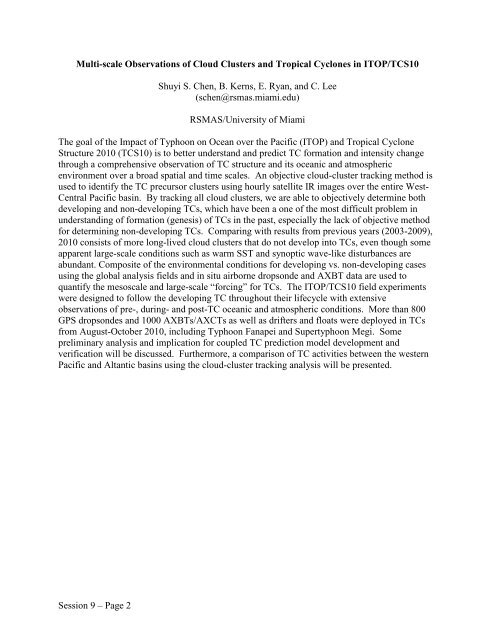65th IHC Booklet/Program (pdf - 4.9MB) - Office of the Federal ...
65th IHC Booklet/Program (pdf - 4.9MB) - Office of the Federal ...
65th IHC Booklet/Program (pdf - 4.9MB) - Office of the Federal ...
Create successful ePaper yourself
Turn your PDF publications into a flip-book with our unique Google optimized e-Paper software.
Multi-scale Observations <strong>of</strong> Cloud Clusters and Tropical Cyclones in ITOP/TCS10<br />
Shuyi S. Chen, B. Kerns, E. Ryan, and C. Lee<br />
(schen@rsmas.miami.edu)<br />
RSMAS/University <strong>of</strong> Miami<br />
The goal <strong>of</strong> <strong>the</strong> Impact <strong>of</strong> Typhoon on Ocean over <strong>the</strong> Pacific (ITOP) and Tropical Cyclone<br />
Structure 2010 (TCS10) is to better understand and predict TC formation and intensity change<br />
through a comprehensive observation <strong>of</strong> TC structure and its oceanic and atmospheric<br />
environment over a broad spatial and time scales. An objective cloud-cluster tracking method is<br />
used to identify <strong>the</strong> TC precursor clusters using hourly satellite IR images over <strong>the</strong> entire West-<br />
Central Pacific basin. By tracking all cloud clusters, we are able to objectively determine both<br />
developing and non-developing TCs, which have been a one <strong>of</strong> <strong>the</strong> most difficult problem in<br />
understanding <strong>of</strong> formation (genesis) <strong>of</strong> TCs in <strong>the</strong> past, especially <strong>the</strong> lack <strong>of</strong> objective method<br />
for determining non-developing TCs. Comparing with results from previous years (2003-2009),<br />
2010 consists <strong>of</strong> more long-lived cloud clusters that do not develop into TCs, even though some<br />
apparent large-scale conditions such as warm SST and synoptic wave-like disturbances are<br />
abundant. Composite <strong>of</strong> <strong>the</strong> environmental conditions for developing vs. non-developing cases<br />
using <strong>the</strong> global analysis fields and in situ airborne dropsonde and AXBT data are used to<br />
quantify <strong>the</strong> mesoscale and large-scale “forcing” for TCs. The ITOP/TCS10 field experiments<br />
were designed to follow <strong>the</strong> developing TC throughout <strong>the</strong>ir lifecycle with extensive<br />
observations <strong>of</strong> pre-, during- and post-TC oceanic and atmospheric conditions. More than 800<br />
GPS dropsondes and 1000 AXBTs/AXCTs as well as drifters and floats were deployed in TCs<br />
from August-October 2010, including Typhoon Fanapei and Supertyphoon Megi. Some<br />
preliminary analysis and implication for coupled TC prediction model development and<br />
verification will be discussed. Fur<strong>the</strong>rmore, a comparison <strong>of</strong> TC activities between <strong>the</strong> western<br />
Pacific and Altantic basins using <strong>the</strong> cloud-cluster tracking analysis will be presented.<br />
Session 9 – Page 2
















